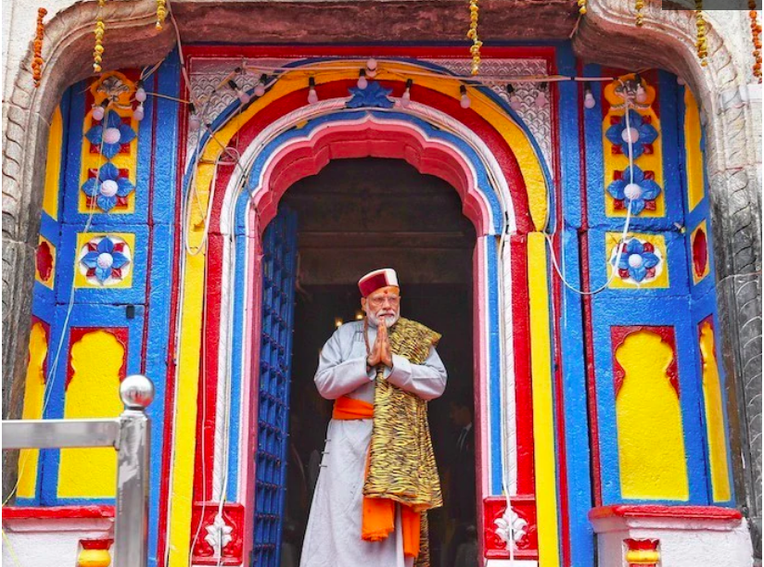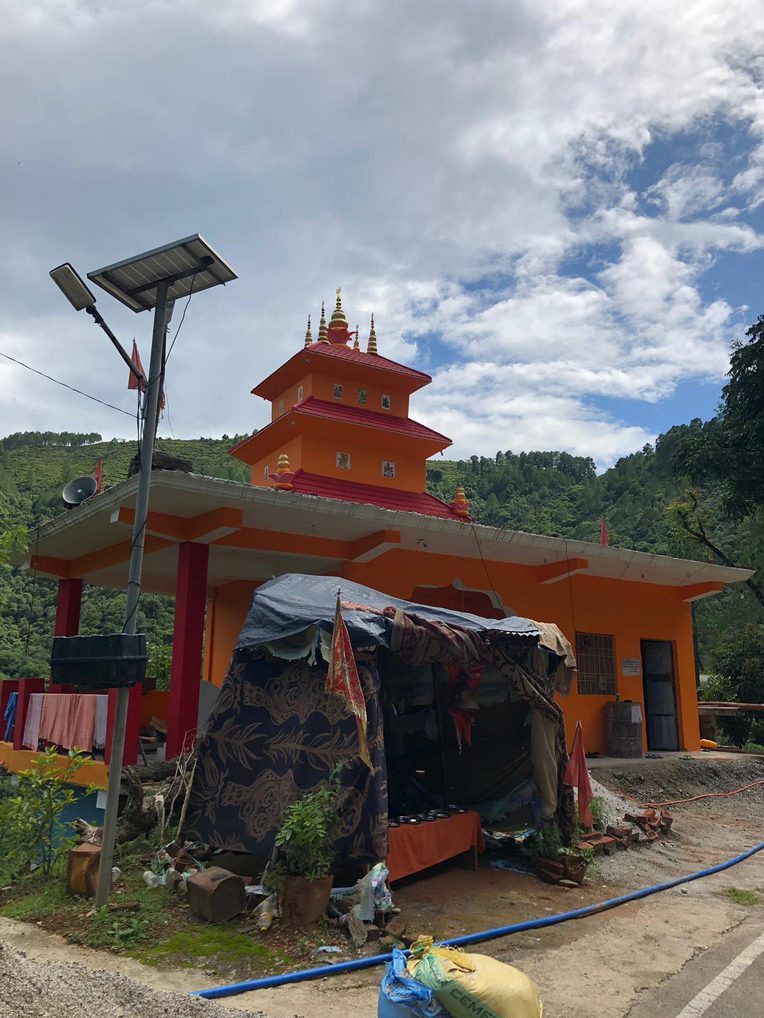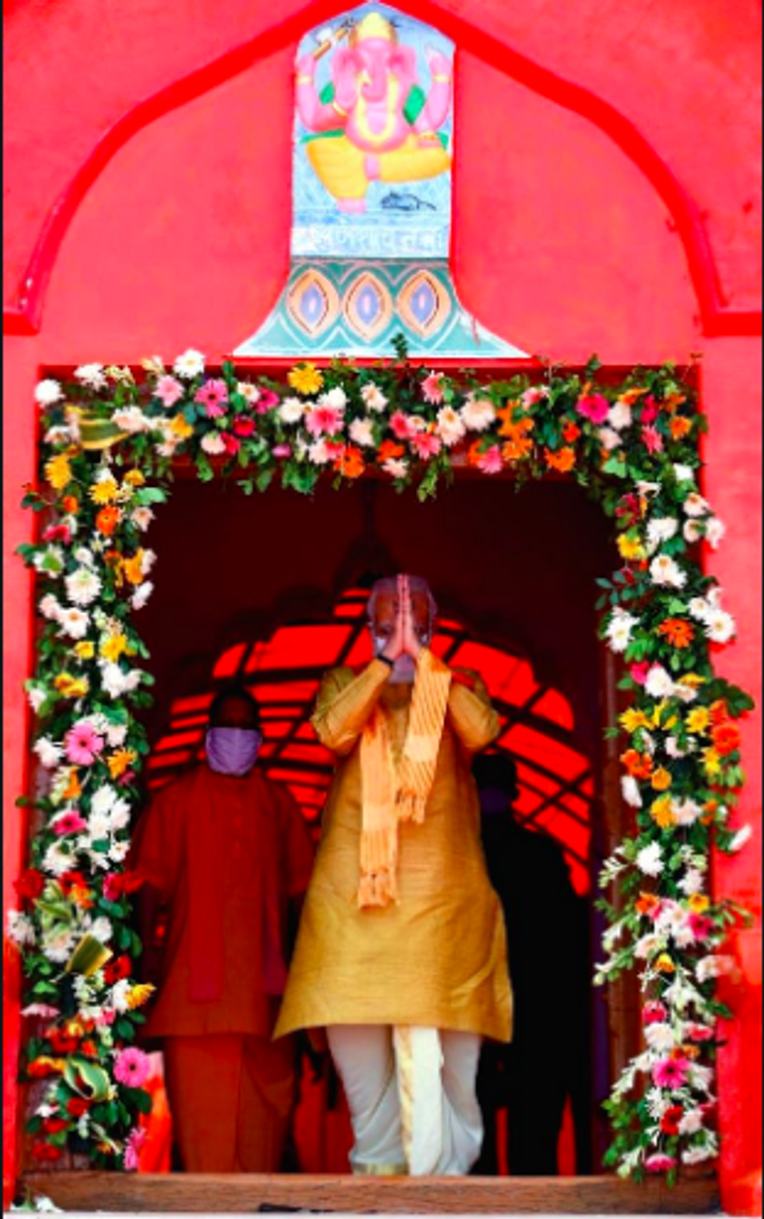Passengers to Pilgrims: Micro-cartographies of Sacredness in the Indian Himalayas
From the Series: Majoritarian Politics in South Asia
From the Series: Majoritarian Politics in South Asia


When Narendra Modi, the current prime minister of India, visited Kedarnath during the 2019 parliamentary elections dressed in a leopard print shawl over a grey robe, complete with an ascetic’s beads around his neck, it made for sensational photo opportunities. One of the four cardinal Hindu temple pilgrimages, Kedarnath in the Himalayan state of Uttarakhand received a “record number of pilgrims” after his visit. Modi’s visits to other temples like Guruvayur in Kerala, Badrinath in Uttarakhand, and Pashupatinath in Nepal also garnered equally widespread attention, especially due to their prompting of temple visits among members of the opposition parties. A focus on the national macro-cartography of canonical temples and their hypervisibility, amplified through such visits, occludes the micro-cartographies that produce and restore such contiguous sacredness, indivisibility, and religiosity. The macro-cartographical imagination of the sacred nation is made possible through the entrenchment of discrete yet collapsible micro-cartographies of sacredness.
My essay focuses on territorial and temporal conceptions of sacredness as they emerge through entanglements with road-infrastructure development and automobility in the Indian Himalayas. They constitute a micro-cartography of sacredness in what is already known as “the land of gods” (devbhoomi). Unlike a transcendent sacred geography of canonical pilgrimage centers (teertha) that imbues a sense of the nation (Eck 2012), these micro-cartographies of sacredness are constituted by more limited circuits of mobility tied to the extension of road networks and mass automobility, manifest most acutely in this case in road accidents. The high incidence of road accidents is a leading cause of death in the Indian Himalayas, commonly described as akaal mrityu (death before its time) and memorialized through roadside archives of death memorials, shrines, and temples. While such roadside archives constitute a micro-cartography that is locally limited in its scale, its sacredness is the ground on which the transcendental sacredness of the nation is etchable.
Between the summer of 2018 and the monsoon of 2019, Suraj (pseudonym) and I traveled on the Pithoragarh-Jhulaghat road on the India-Nepal border nearly two dozen times. The stretch is a little over thirty kilometers long and inscribed with several road accident memorial shrines and temples. During our commutes, we were made aware of their origin by co-passengers and drivers, who often saw them as milestones. Outstanding among them in form and scale is a temple that was under construction when we first came across it in June 2018. The niche for the central temple deity was noticeably vacant but the crimson-orange hue of the inside walls and the paste on offer in the trays indicated that it was a Hanuman Temple. Not far from it was a worn-out roadside memorial for an akaal mrityu and even closer, a tented arrangement enclosing an uninterrupted pyre (dhooni) and a bench over which were laid several plates with auspicious offerings for passengers who cared to stop by and/or offer a donation.
Siddheshwar Nath (pseudonym), the caretaker-cum–resident saint (baba) at the temple described to us how Hanuman had been established in 2011 to prevent the continuous tragedy of road accidents and is still under construction. The sanctum sanctorum lacks the presiding deity but that has not diminished the protection that it offers as a temple. Siddheshwar is a wandering ascetic of the Gorakhpanth. “You must have heard of Yogi ji, he is my gurubhai [of the same monastic order],” he declared to the small group that had gathered in the temple courtyard. Gorakhpanthis are followers of the Nath tradition and venerate Hanuman. Yogi Adityanath, the current chief minister of Uttar Pradesh was previously the chief priest of the Gorakhnath Math (monastic temple). He held the parliamentary seat from Gorakhpur, the headquarters of the Gorakhpanth order from 1998 to 2017, which Shashank Chaturvedi, David N. Gellner, and Sanjay Kumar Pandey (2019) describe as a crucial phase in the consolidation of Gorakhpur as a “safe ‘Hindu’ constituency.”
Siddeshwar recounted for us the various road accidents along with their gory details. A young man, a goat, a cow, a junior engineer at the public works department, a police constable . . . Over the next few weeks, I met Siddheshwar often on my way to Jhulaghat, a passenger-pilgrim myself. Other passenger-pilgrims had begun to stop too, either from within the taxi to bow their heads in respect and offer a contribution or to alight and pay their respects to Siddheshwar. “This is devbhoomi but the gods need to be propitiated to maintain their sacred protection,” he would tell me repeatedly. When I met him again in 2019, the temple was nearing completion even as Hanuman was yet to be installed. Passengers were stopping by and heeding Siddheshwar’s advice on various matters; he had organized a reading of a section of the epic Ramayana for the coming Tuesday, inviting all those who were passing by to attend. Meanwhile, the temple claimed to have halted the spate of road accidents or, as Siddheshwar liked to suggest, of narbali (human sacrifice) and had received monetary contributions from the legislator’s fund and the district council in addition to the Gorakhnath trust for “beautification.”

Roadside temples emerge as portals for reconstituting the profanity of death before its time into a micro-cartography of sacredness that reckons intimately with the imagined contiguity of a sacred nation, regularly transformed through the development of roads and the incidence of road accidents. Moving along these micro-cartographies articulated most prominently through the emergent temple Hindu religiosities, passengers are iteratively shaped into pilgrims of a geography turning sacred before them. Automobility is not the secularization of space but the making of a pilgrimage faced with the uncertainty and threat of death before time marked on the landscape. As the “sacred” proliferates and canonizes animals, rivers, and tourism in the already sacred “land of gods,” these micro-cartographies draw our attention to the ways in which the sacred is reinscribed on a quotidian basis. It is harnessed into the imaginary of the sacred nation, interlinking the local micro-cartographies with the majoritarian impulses of the macro-cartography. The sacredness of the macro-cartography of the nation evoked in the iconic emblems of its majoritarian religiosity, as it was during the foundation-laying ceremony of the Ram temple in Ayodhya in August 2020, is embodied in the network of the micro-cartographies of sacredness. The sacredness of the nation’s territory is canonized into national consciousness each time temples, pilgrims, and temple Hinduism are perceived to be “threatened”—whether through disaster (Kedarnath and Badrinath in 2013), “terrorism” (Amarnath in 2017 and 2019), menstruating women (Sabarimala in 2018), inter-communal conflict (Ram Janmbhoomi Sthan in 1992, 2019, and 2020), or Dalits (temple entry movement 1920s), the groundwork for which can be traced in the micro-cartographies of sacredness reproducing its contiguous indivisibility.

Chaturvedi, Shashank, David N. Gellner, and Sanjay Kumar Pandey. 2019. “Politics in Gorakhpur since the 1920s: The Making of a Safe ‘Hindu’ Constituency.” Contemporary South Asia, 27, no. 1: 40–57.
Eck, Diana L. 2012. India: A Sacred Geography. New York: Harmony Books.